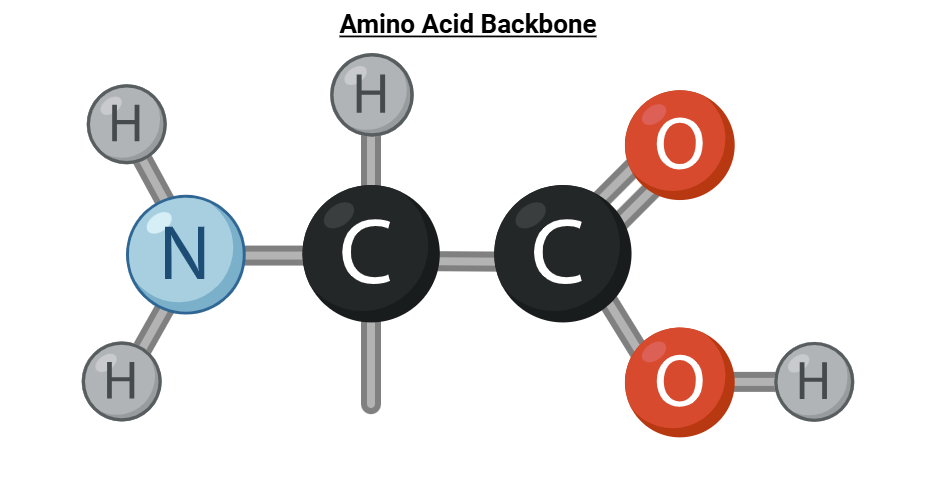Amino acids are chemical compounds that act as the basic building blocks for proteins. They perform vital functions in a variety of biological processes and are required for development, repair, and good health. This article looks at the structure, classification, functions, and significance of amino acids in the human body.
Structure of Amino Acids
Amino acids have a distinctive structure that sets them apart from other chemical compounds. Understanding this structure is critical to comprehending their role in biological systems.
Central Carbon Atom (C)
Each amino acid contains a central carbon atom, known as the alpha carbon (Cα). This carbon is tetrahedral in shape, meaning it is bonded to four different groups, resulting in a three-dimensional structure critical to the amino acid’s functioning.
Amino Group (NH₂)
The amino group is made up of one nitrogen atom (N) linked to two hydrogen atoms. It is a fundamental functional group that aids in the creation of peptide bonds during protein synthesis. The presence of this group gives amino acids their name, with “amino” referring to the nitrogen-containing component. Under some conditions, like as physiological pH, the amino group can receive a proton (H⁺) and become positively charged.
Carboxyl Group (COOH)
The carboxyl group consists of a carbon atom double-bonded to an oxygen atom (C=O) and a single-bonded hydroxyl group (-OH). This group confers acidic characteristics on amino acids, allowing them to transfer protons. At physiological pH, the carboxyl group is normally deprotonated, carrying a negative charge that adds to the amino acid’s total charge.
Hydrogen Atom (H)
A single hydrogen atom is linked to the center carbon. This atom is not important to the chemical behavior of amino acids, but it is part of the backbone structure.
R Group (Side Chain)
The R group, often known as the side chain, is the changeable component of an amino acid that distinguishes it from other amino acids. The nature of the R group influences the amino acid’s characteristics.
- R groups can be as simple as one hydrogen atom (as in glycine) or as complex as tryptophan.
- R groups may be polar (hydrophilic) or non-polar (hydrophobic). This feature effects amino acid solubility in water as well as their interactions with proteins.
- Some R groups are acidic or basic, which affects the total charge of the amino acid at various pH values.
Also Read: What is a Bioreactor? Explanation and Structure
Isomerism in Amino Acids
Amino acids can exist as isomers, owing to the existence of chiral alpha carbon. Most amino acids are chiral, which means they can exist in two mirror-image forms (enantiomers): L (levo) and D (dextro). In biological systems, proteins are made up entirely of L-amino acids.
Classification of Amino Acids
Essential & Non-Essential
Essential Amino Acids: These are not produced by the body and must be received from food. Humans require nine essential amino acids, which include leucine, isoleucine, and valine.
Non-Essential Amino Acids: Alanine, aspartic acid, and glutamic acid are examples of compounds that the body can generate.
Polar & Non-Polar
Polar Amino Acids: These have side chains that can make hydrogen bonds with water, making them hydrophilic. Examples include serine and threonine.
Non-Polar Amino Acids: These have hydrophobic side chains, which do not interact well with water. Examples include leucine and phenylalanine.
Acidic & Basic
Acidic Amino Acids: Aspartic acid and glutamic acid are examples of compounds with a carboxyl group on their side chain.
Basic Amino Acids: These have an amino group in the side chain, like lysine and arginine.
Also Read: Immunoglobulin (Antibody) – Structure and Types
Functions of Amino Acids
- Proteins, which are essential for biological structure and function, are formed by linking amino acids together via peptide bonds.
- Many enzymes are proteins that catalyze biological reactions; their structure is governed by the amino acid sequence.
- Some hormones, such as insulin and glucagon, are proteins derived from amino acids that play important functions in metabolism.
- Antibodies, which are proteins, aid the immune system in recognizing and neutralizing infections.
Image: BioRender
Last Modified:




